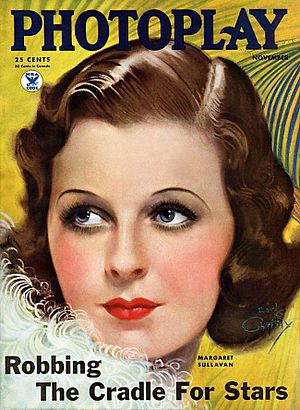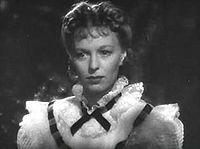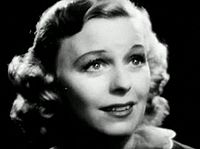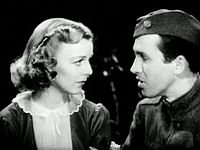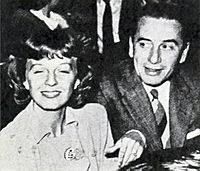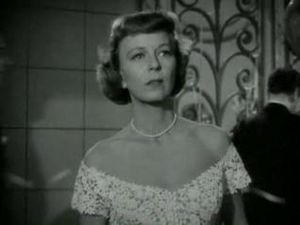Margaret Sullavan facts for kids
Quick facts for kids
Margaret Sullavan
|
|
|---|---|
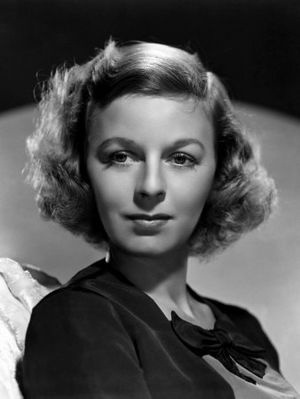
Sullavan in 1940
|
|
| Born |
Margaret Brooke Sullavan
May 16, 1909 Norfolk, Virginia, U.S.
|
| Died | January 1, 1960 (aged 50) New Haven, Connecticut, U.S.
|
| Resting place | Saint Mary's Whitechapel Episcopal Churchyard |
| Occupation | Actress |
| Years active | 1929–1960 |
| Spouse(s) |
Leland Hayward
(m. 1936; div. 1948)Kenneth Wagg
(m. 1950) |
| Children | 3, including Brooke Hayward |
Margaret Brooke Sullavan (born May 16, 1909 – died January 1, 1960) was a famous American actress. She performed on both the stage and in movies.
Margaret Sullavan started her acting journey on stage in 1929. Her first movie role came in 1933 in a film called Only Yesterday. She became well-known for her work in movies like The Shop Around the Corner.
Even though she was a movie star, Margaret preferred acting on stage. She only made 16 films in total. Four of these movies were with her good friend, actor James Stewart. They were a popular acting pair in films like The Mortal Storm and The Shop Around the Corner. Margaret Sullavan was also friends with Henry Fonda, and they were married for a short time.
She was nominated for an Academy Award for Best Actress for her role in Three Comrades (1938). Margaret stopped making movies in the early 1940s to spend more time with her children and focus on stage plays. She returned to movies one last time in 1950 for No Sad Songs for Me, where she played a woman facing a serious illness. After that, she only acted on stage. Some of her famous stage roles included Terry Randall in Stage Door and Sally Middleton in The Voice of the Turtle.
In her later years, Margaret Sullavan experienced hearing problems and sadness. She passed away on January 1, 1960, when she was 50 years old.
Contents
Early Life and Childhood
Margaret Sullavan was born in 1909 in Norfolk, Virginia. Her father, Cornelius Sullavan, was a wealthy stockbroker. She had a younger brother and a half-sister.
When she was very young, Margaret had a muscle weakness in her legs. This made it hard for her to walk and play with other children until she was six years old. After she recovered, she became a very adventurous and playful child. She liked playing with kids from less wealthy neighborhoods, which her parents did not always approve of. She first performed dances at her Sunday School.
Margaret went to a boarding school called Chatham Episcopal Institute. She was the student body president there. After school, she moved to Boston to study dance and drama. Her parents didn't want her to be an actress, so they cut her allowance. Margaret worked at a bookstore to pay for her studies.
Margaret Sullavan's Acting Career
Starting on Stage
Margaret Sullavan got her first acting part in a musical in 1929. The leaders of the Harvard Dramatic Society and Princeton's Theatre Intime invited her to join their acting group, the University Players. Another member of this group was Henry Fonda.
In the summer of 1929, Margaret acted opposite Henry Fonda in her first professional play, The Devil in the Cheese. She continued to perform with the University Players for several seasons.
Margaret's parents were not happy about her choice to become an actress. However, when they saw her perform in the play Strictly Dishonorable (1930), they realized how talented she was. Margaret later said she was relieved they finally stopped complaining.
A talent scout saw her in that play. Margaret had a very husky voice because of a bad case of laryngitis at the time. The scout loved her voice, and Margaret later joked that she kept her voice husky on purpose.
Margaret made her Broadway debut in a play called A Modern Virgin in May 1931. She then went on tour with the play.
In 1932, she acted in four Broadway plays that didn't do well. But critics always praised Margaret's performances. In March 1933, a movie director named John M. Stahl saw her in a play called Dinner at Eight. He thought she would be perfect for his upcoming movie, Only Yesterday.
Margaret had already turned down big movie contracts. But she accepted a three-year contract for two movies a year, earning $1,200 each week. She made sure her contract allowed her to return to the stage whenever she wanted. Later in her career, she only signed short-term contracts because she didn't want any studio to "own" her.
Hollywood Film Roles
Margaret Sullavan arrived in Hollywood on her 24th birthday, May 16, 1933. Her first movie, Only Yesterday, came out that same year. When she saw herself in the early film clips, she was so upset that she tried to buy her contract back, but the studio refused.
Her next movie was Little Man, What Now? (1934). This film was about a couple struggling during hard times in Germany after World War I. Margaret felt this movie was very important, and it was one of the few Hollywood roles she truly enjoyed.
In The Good Fairy (1935), Margaret showed how versatile she was as an actress. She married the director of this film, William Wyler, during its production.
The movie So Red the Rose (1935) was about people in the Southern United States after the Civil War. Margaret played a young Southern girl who grows into a responsible woman.
In Next Time We Love (1936), Margaret acted alongside James Stewart, who was not yet famous. Margaret had pushed for him to be her co-star. The movie was about a married couple growing apart. This was the first of four films Margaret and James Stewart made together.
In the comedy The Moon's Our Home (1936), Margaret acted with her ex-husband, Henry Fonda. They played a newly married couple. Her seventh film, Three Comrades (1938), was a drama set in Germany after World War I. She received an Oscar nomination for her role and was named the best actress of the year by the New York Film Critics.
Margaret reunited with James Stewart in The Shopworn Angel (1938). Stewart played a sweet soldier who marries Margaret's character. Her ninth film was The Shining Hour (1938). In The Shop Around the Corner (1940), Margaret and Stewart worked together again. They played co-workers who were secretly writing letters to each other without knowing it.
In 1940, Margaret also appeared in The Mortal Storm, a film about Germans during the rise of Adolf Hitler. Back Street (1941) is considered one of her best Hollywood performances. So Ends Our Night (1941) was a wartime drama where Margaret played a Jewish person escaping the Nazis.
A court decision in 1940 meant Margaret had to make two more films for Universal Studios. These were Back Street (1941) and the comedy Appointment for Love (1941).
Cry 'Havoc' (1943) was Margaret's last film with Metro-Goldwyn-Mayer. After this movie, she was free from all her film contracts. She often called the movie studios "jails."
Working with James Stewart
Margaret Sullavan's movies with James Stewart are some of the most memorable parts of their early careers. In 1935, Margaret wanted to make the film Next Time We Love. She thought the script had a perfect role for Stewart, who was a close friend of her first husband, Henry Fonda. Years before, Margaret had predicted that Stewart would become a big Hollywood star.
By 1936, James Stewart was working for MGM but only getting small roles. Margaret suggested that Universal Studios test Stewart to be her leading man. He was borrowed from MGM to star with Margaret in Next Time We Love. Stewart was nervous at first, but Margaret believed in him. She spent evenings coaching him and helping him improve his acting. The director later said, "It was Margaret Sullavan who made James Stewart a star."
Margaret and Stewart's second film together was The Shopworn Angel (1938). Another actor in the film, Walter Pidgeon, said it was clear Stewart was in love with Margaret. He came alive in his scenes with her. Margaret Sullavan and James Stewart appeared in four films together between 1936 and 1940.
Later Career and Stage Work
Margaret Sullavan took a break from movies from 1943 to 1950. She always preferred the stage because she felt it helped her improve her acting skills. She once said, "As long as the flesh-and-blood theatre will have me, it is to the flesh-and-blood theatre I'll belong."
Another reason she stopped making movies in 1943 was to spend more time with her three children: Brooke, Bridget, and Bill. She felt she had been neglecting them. Margaret still performed on stage sometimes. From 1943 to 1944, she played Sally Middleton in The Voice of the Turtle on Broadway and later in London.
After her brief return to movies in 1950 with No Sad Songs for Me, she didn't return to the stage until 1952. Her next stage role was Hester Collyer in The Deep Blue Sea. In 1953, she agreed to appear in Sabrina Fair.
In No Sad Songs for Me, Margaret played a wife and mother who learns she will die from cancer. She then tries to find a new wife for her husband. Natalie Wood, who was 11 at the time, played their daughter. After the movie received good reviews, Margaret had many offers for other films. However, she decided to focus only on stage acting for the rest of her career.
In 1955–1956, Margaret Sullavan appeared in a comedy play called Janus. She played Jessica, who writes under the name Janus. The play ran for 251 performances.
In the late 1950s, Margaret's hearing problems and sadness became worse. However, in 1959, she agreed to do a new play called Sweet Love Remembered. It was her first Broadway appearance in four years. Rehearsals began in December 1959. She had mixed feelings about acting again and her sadness was clear to everyone. She said, "I loathe acting... You cannot live while you are working."
In December 1955, Margaret Sullavan appeared as a mystery guest on the TV show What's My Line?
Margaret Sullavan's Personal Life
Marriages and Family
Margaret Sullavan was married four times. At age 22, she married actor Henry Fonda on December 25, 1931. They were both performing with the University Players at the time. They separated after two months and divorced in 1933, but they remained friends. Their children also became friends. Henry Fonda's daughter, Jane Fonda, remembered Margaret as being very athletic. She said Margaret could walk on her hands.
After separating from Fonda, Margaret had a short relationship with Broadway producer Jed Harris. Then, while filming The Good Fairy, she started a relationship with the director, William Wyler. They married in November 1934 and divorced in March 1936.
Margaret's third marriage was to her agent and producer, Leland Hayward. They married on November 15, 1936, when Margaret was expecting their first child. They had three children: Brooke Hayward, Bridget, and William III. Brooke later became an actress and writer. In 1947, Margaret filed for divorce, and it became final in April 1948.
In 1950, Margaret married for the fourth and final time to an English investment banker named Kenneth Wagg. They stayed married until her death in 1960.
Hearing Challenges
Margaret Sullavan had a hearing problem called otosclerosis from birth. This condition got worse as she got older, making her more and more hearing-impaired. Her voice became husky because she could hear low sounds better than high ones. By early 1957, her hearing was so bad that she became sad and had trouble sleeping.
Margaret kept her hearing problem mostly a secret. She had an operation in the late 1940s that helped her left ear, but she didn't follow the doctor's advice to avoid activities like diving or flying.
Margaret Sullavan's Passing
On January 1, 1960, Margaret Sullavan was found unconscious in a hotel room in New Haven, Connecticut. She was rushed to the hospital but was pronounced dead shortly after. She was 50 years old.
A private memorial service was held in Greenwich, Connecticut. Her former co-star Joan Crawford and other friends attended. Margaret Sullavan was buried at Saint Mary's Whitechapel Episcopal Churchyard in Lancaster, Virginia.
For her contributions to the movie industry, Margaret Sullavan has a star on the Hollywood Walk of Fame. She was also honored by being included in the American Theater Hall of Fame in 1981.
Selected Filmography
| Year | Title | Role | Notes |
|---|---|---|---|
| 1933 | Only Yesterday | Mary Lane | |
| 1934 | Little Man, What Now? | Emma "Lämmchen" Pinneberg | |
| 1935 | The Good Fairy | Luisa "Lu" Ginglebusher | |
| 1935 | So Red the Rose | Valette Bedford | |
| 1936 | Next Time We Love | Cicely Tyler | |
| 1936 | The Moon's Our Home | Cherry Chester/Sarah Brown | |
| 1938 | Three Comrades | Patricia "Pat" Hollmann | |
| 1938 | The Shopworn Angel | Daisy Heath | |
| 1938 | The Shining Hour | Judy Linden | |
| 1940 | The Shop Around the Corner | Klara Novak | |
| 1940 | The Mortal Storm | Freya Roth | |
| 1941 | Back Street | Ray Smith | |
| 1941 | So Ends Our Night | Ruth Holland | |
| 1941 | Appointment for Love | Dr. Jane Alexander | |
| 1943 | Cry 'Havoc' | Lt. Mary Smith | |
| 1950 | No Sad Songs for Me | Mary Scott |
Radio Appearances
| Year | Program | Episode/source |
|---|---|---|
| 1935 | Lux Radio Theatre | Peg o' My Heart |
| 1937 | Lux Radio Theatre | The Petrified Forest |
| 1938 | Lux Radio Theatre | Next Time We Love |
| 1938 | The Campbell Playhouse | Rebecca |
| 1940 | Screen Guild Players | The Shop Around the Corner |
See also
 In Spanish: Margaret Sullavan para niños
In Spanish: Margaret Sullavan para niños


